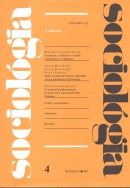Makrospoločenské faktory súčasného vývoja pôrodnosti na Slovensku
Macrosocial Factors of Contemporary Fertility Developments in Slovakia
Author(s): Jozef Matulník, Alojz Ritomský, Karol PastorSubject(s): Social Sciences
Published by: SAV - Slovenská akadémia vied - Sociologický ústav
Keywords: Macrosocial factors; fertility developments; cultural factors; socioeconomic factors; demographic transition
Summary/Abstract: Macrosocial Factors of Contemporary Fertility Developments in Slovakia. A sharp decline in fertility which has taken place in Slovakia since the early 1990s is the topic of discussion of sociologists, demographers, economists and other experts for a longer time and it also attracts interest of the wider public. The very last development supports importance of this issue. In 2001 the natural increase rate was minus 844 persons. It should be observed that during the twentieth century the population of Slovakia only experienced decline during the period 1916-1918, and this was because of the particular effects of the Great War. A team of researchers examined the reasons behind these recent developments. Partial results of this investigation into the determinants of fertility developments in Slovakia are presented in this study. The study attempts to obtain answers to two main research questions: a) to what extent are contemporary fertility developments in Slovakia influenced by cultural factors? b) To what extent are they influenced by socioeconomic factors? The first question concerns the influence of the second demographic transition. The second question deals with housing shortage, low living standards etc. The study is divided into seven parts. In the first, authors discuss the approach and methodology used in their analysis. The second part contains a description of the situation of expected fertility in Slovakia in relation to geographical regions, age groups, men and women, religiosity, and ethnic groups. The third part examines the relationship between expected fertility and attitudes towards life-long marriage. The relationship between expected fertility and attitudes towards cohabitation, sexual contact between teenagers, and extra-marital sexual relations between married people is discussed in part four. Attitudes to different means of fertility control are analyzed in part five. The sixth part is devoted to socioeconomic factors: cluster analyses were computed and different categories of people influenced by different socioeconomic factors were identified. Some conclusions regarding prognosis of the future fertility development is outlined in the last part of the study. Sociológia 2003 Vol. 35 (No. 4: 307-332)
Journal: Sociológia - Slovak Sociological Review
- Issue Year: 2003
- Issue No: 4
- Page Range: 307-332
- Page Count: 26
- Language: Slovak

